
Anguidae refers to a large and diverse family of lizards native to the Northern Hemisphere. Common characteristics of this group include a reduced supratemporal arch, striations on the medial faces of tooth crowns, osteoderms, and a lateral fold in the skin of most taxa. The group includes the slowworms, glass lizards, and alligator lizards, among others. The family is divided into two subfamilies, and contains about 87 species in 8 genera.
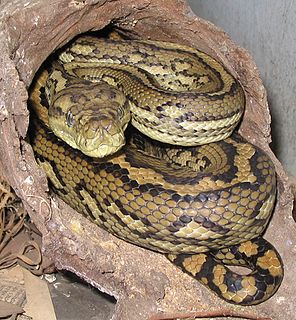
Morelia spilota, commonly referred to as the carpet python, is a large snake of the family Pythonidae found in Australia, New Guinea, Bismarck Archipelago, and the northern Solomon Islands. Many subspecies are described; ITIS lists six, the Reptile Database six, and the IUCN eight.

Craspedocephalus macrolepis, commonly known as the large-scaled pit viper, is a venomous pitviper species endemic to the Southern Western Ghats of South India. No subspecies are currently recognized.

The Collared Cat Snake, Boiga nuchalis, is a species of nocturnal, tree-dwelling, rear-fanged colubrid snake endemic to southwestern India.
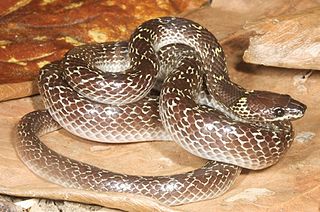
Lycodon capucinus, also known as the Oriental wolf snake, is a species of colubrid snake, which is commonly found in the Indo-Australian Archipelago. Named after their enlarged front teeth, which gives them a muzzled appearance similar to canines, it also makes the snout somewhat more squarish than other snakes.

Ptyas mucosa, commonly known as the oriental ratsnake, Indian rat snake, darash or dhaman, is a common non-venomous species of colubrid snake found in parts of South and Southeast Asia. Dhamans are large snakes. Typical mature total length is around 1.5 to 1.95 m though some exceed 2 m. The record length for this species was 3.7 m, second only to their cousin Ptyas carinata among living colubrid snakes. Despite their large size, oriental ratsnakes are usually quite slender with even a specimen of 2 m commonly measuring 4 to 6 cm only around in diameter. Furthermore, the average weight of ratsnakes caught in Java was around 877 to 940 g, though larger males of over 2.3 m may easily weigh over 2.5 kg (5.5 lb). Their color varies from pale browns in dry regions to nearly black in moist forest areas. Rat snakes are diurnal, semi-arboreal, non-venomous, and fast-moving. Rat snakes eat a variety of prey and are frequently found in urban areas where rodents thrive.

Tantilla is a large genus of harmless New World snakes in the family Colubridae. The genus includes 66 species, which are commonly known as centipede snakes, blackhead snakes, and flathead snakes.

Opheodrys aestivus, commonly known as the rough green snake, is a nonvenomous North American colubrid. It is sometimes called grass snake or green grass snake, but these names are more commonly applied to the smooth green snake. The European colubrid called grass snake is unrelated. The rough green snake is docile, often allowing close approach by humans, and seldom bites. Even when bites occur, they have no venom and are harmless.
Hobart Muir Smith, born Frederick William Stouffer, was an American herpetologist. He is credited with describing more than 100 new species of American reptiles and amphibians. In addition, he has been honored by having at least six species named after him, including the southwestern blackhead snake, Smith's earth snake, Smith's arboreal alligator lizard, Hobart's anadia, Hobart Smith's anole, and Smith's rose-bellied lizard. At 100 years of age, Smith continued to be an active and productive herpetologist. Although he published on a wide range of herpetological subjects, his main focus throughout his career was on the amphibians and reptiles of Mexico, including taxonomy, bibliographies, and history. Having published more than 1,600 manuscripts, he surpassed all contemporaries and remains the most published herpetologist of all time.
Machadoe's girdled lizard is a flattened girdled lizard from southwestern Angola and northwestern Namibia. They are found as solitary individuals or in pairs on rock outcrops in arid savannah. It can be identified, along with Cordylus vittifer, by have an elongate first row of dorsal scales. Machadoe's girdled lizard is uniform yellow brown above and paler below. The head is dark brown with pale lips. The pale vertebral stripe found in the Cordylus vittifer is not present. Adults reach 78 mm in length from snout to vent.
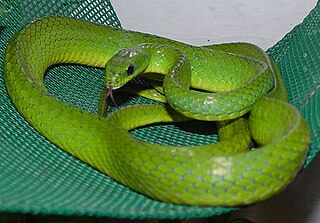
The greater green snake or Chinese green snake is a snake of the family Colubridae.

Telescopus semiannulatus, commonly known as the common tiger snake, tiger cat snake, or eastern tiger snake is a species of rear-fanged colubrid snake. It is widespread in central, eastern, and southern Africa.
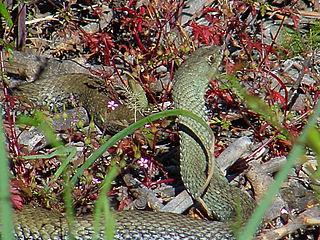
Psammophiidae is a family of elapoid snakes. They were formerly placed as a subfamily of the Lamprophiidae, but have been more recently identified as a distinct family.
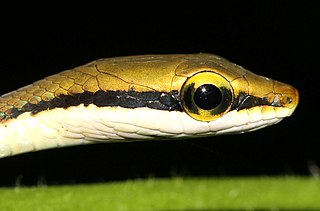
Dendrelaphis girii, or Giri's bronzeback tree snake, is a species of diurnal, arboreal, Colubrid snake endemic to the Western Ghats of southwestern India.

Hemirhagerrhis is a genus of snakes in the family Psammophiidae.
The Namib day gecko is a species of lizard in the family Gekkonidae. The species is found in the deserts of Namibia and southern Angola. It is the type species of the genus Rhoptropus.

Pareidae is a small family of snakes found largely in southeast Asia, with an isolated subfamily endemic to southwestern India. It encompasses 42 species in four genera divided into two subfamilies: Pareinae and Xylophiinae. Both families are thought to have diverged from one another during the early-mid Eocene, about 40-50 million years ago.

Anderson's stream snake, also known commonly as Anderson's mountain keelback, is a species of snake in the family Colubridae. The species is native to Asia
Natriciteres bipostocularis, the southwestern forest marsh snake, is a species of natricine snake found in Zambia, the Democratic Republic of the Congo, and Angola.














